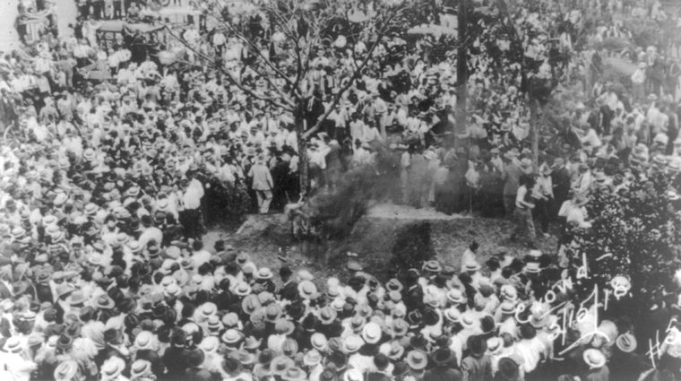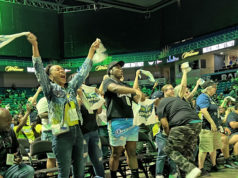One hundred years ago this week, Jesse Washington, an 18-year-old African-American man, was burned at the stake in Waco.
On May 8, 1916, a 53-year-old white woman named Lucy Fryar was bludgeoned to death outside her home, seven miles south of the city. The chief and only suspect was Washington, an illiterate farmhand who worked for Lucy and her husband George.
Reported to have anger issues and mental disabilities, Washington allegedly left his cotton plow to get more seed from Mrs. Fryar. As she was measuring cotton seed out, she reportedly scolded him for his harsh treatment of the plow mules. Washington took offense, striking her in the head with a blacksmith’s hammer. He then allegedly raped and killed her.
Afterward, he apparently resumed his work in the Fryar cotton field and then returned home to the cabin he shared with his parents. When the body of Mrs. Fryar was discovered, authorities immediately suspected Washington and found him whittling a stick in his parents’ backyard.
McLennan County authorities arrested Washington and transported him to the county jail but transferred him shortly thereafter. Considering the nature of the crime and the ethnicity of the chief suspect, they knew a lynching party would appear, so they conveyed Washington to Dallas.
On May 9, McLennan County Sheriff Sam S. Fleming and County Attorney John B. McNamara announced that Washington (who was still in Dallas County) had confessed (possibly under duress) and signed his “X” to a written confession. Sheriff Fleming and McNamara also reported that Washington had indicated where the murder weapon was located and officials reportedly discovered it in that very spot.
A McLennan County grand jury was subsequently convened and Washington was indicted for murder (not rape) in absentia. He was returned in the middle of the night on May 15 and stealthily delivered the following morning to the courthouse. The courtroom where his case was tried had the capacity for 500 people and was reportedly stuffed with 1,500. The trial, presided over by District Judge R. L. Munroe, began at 10 a.m. and was over before 11 a.m.
Washington pleaded guilty and before Judge Munroe had even finished recording the verdict, a large man in rear of the court room shouted “Get the Nigger.” In seconds the mob was upon Washington while Sheriff Fleming (who had ordered his men not to obstruct the anticipated vigilantism) and the court stenographer sneaked out a side door. Judge Munroe watched helplessly if not passively.
The mob secured Washington with a chain, dragged him out of the courthouse and then escorted him over to a yard next to Waco City Hall. While en route, he was “half-led, half-dragged and pushed all the time,” according to the of the May 15, 1916, edition of the Dallas Morning News, members of the attending mob ripping off his clothes, slicing off one of his ears and several of his fingers, stabbing him repeatedly (up to 25 times according to some accounts) and castrating him.
The mob had placed a large amount of kindling under a tree in the yard, and when the grotesque procession reached it, the chain securing Washington (who was now covered in his own blood) was tossed over a sturdy limb. A fire was lit, and Washington was suspended by the chain over it. As the flames rose, the crowd (which now included women and children) roared with delight as Washington impossibly but reflexively attempted to climb the chain with his fingerless hands. Washington was lowered and raised into and out of the flames for maximum effect. Waco Mayor John Dollins watched from his 2nd floor city hall window, and the Waco Chief of Police stood among the 10,000-15,000 onlookers.
After the conflagration died down, Washington’s charred torso (with flame-severed limbs) was raised high in the tree and the chain tied off so Waco citizens could get their picture taken with it. Then pranksters on horseback cut Washington’s remains down, placed the blackened cadaver in a tow sack, and dragged it through the city streets. The torso was later attached to a car and drug to the Robinson community, where it was hung from a telephone pole.
A Waco photographer named Fred Gildersleeve chronicled the event, and his pictures appeared in newspapers around the country. He would later immortalize some of the images in lynching postcards, but the citizens of Waco eventually grew squeamish and asked Gildersleeve to refrain from exploiting the incident. The photos were casting the entire community in a disturbing light.
In recent years, a persistent Waco contingent has proposed a historical marker acknowledging what came to be known as the Waco Horror, but the effort has been met with considerable opposition.
For the 100th anniversary of the atrocity tomorrow (Sat., May 15), there will be a memorial service at 2 p.m. hosted by the McLennan County Community Race Relations Coalition at the Bledsoe Miller Recreation Center, 300 N. MLK Blvd.
E. R. Bills is the author of Black Holocaust: The Paris Horror and a Legacy of Texas Terror (2015).













Fine piece of work Mr. Bills, as always. You’re a good man. Thank you very kindly. Peace!
He got what he deserved. He killed an innocent woman in cold blood. I would want the same justice for my family member. I wish we would deal with criminals in the same way today. Maybe it would deter some of them from committing such atrocities and save taxpayer money in feeding and housing these animals.
You are fucking stupid, I hope you know that